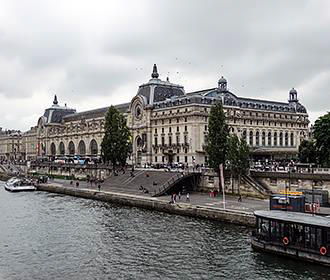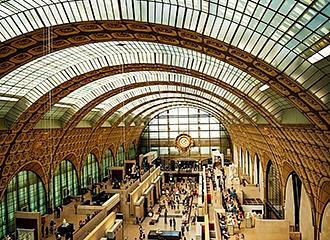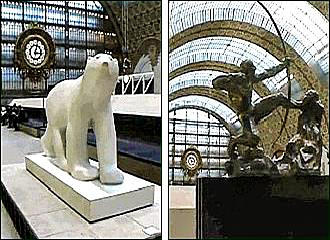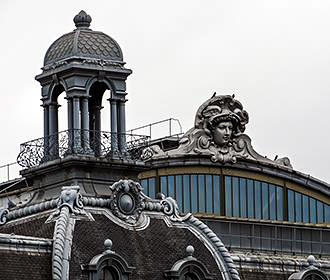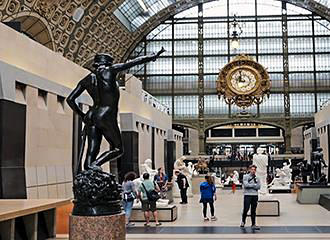History of the Musee d’Orsay in Paris
The Musee d’Orsay is located on the banks of the River Seine opposite the Tuileries Gardens in a former railway station, and it follows on from the Musee du Louvre with its collections of art that date from 1848 through to 1914.
The actual history of the Musee d’Orsay is fascinating and this museum in Paris has been designed in such a way as to encompass the architecture of the original building, which today has also been classified as an historical monument in Paris within its own right.
The location as it was centuries ago
Back at the start of the 1600s, the Rue de Lille was a central lane of a garden that belonged to Marguerite de Vaolois, who was the wife of King Henry IV, but after she died in 1615 the property and gardens were sold off and private mansions started to be built around here and in the local vicinity.
There was also a port known as the Grenouilliere along the River Seine that served barges and cargo boats for wood and other merchandise, yet it was not until the year 1708 that plans were drawn up and construction started on a new quay close to the Pont Royal, which was named the Quai d’Orsay.
At this time the aristocratic neighbourhood was already well established in this area, especially when the Hotel de Salm was built between the years 1782 and 1788, which is now home to the Musee de la Legion d’Honneur. But the Quai d’Orsay was never actually completed until the reign of Napoleon Bonaparte, almost a century after construction first started.
Also, way before the railway station there were two other significant buildings constructed on the site and the first was cavalry barracks designed by the architect Jean-Charles Bonnard and the other was the Palais d’Orsay by the architect Jacques Lacornee. Built between the years 1810 through to 1838, originally the palace was meant to be for the Ministry of Foreign Affairs, however, it eventually housed the Court of Accounts and the State Council.
Yet in 1871, during the violence that ensued during the Paris Commune, the entire aristocratic neighbourhood along with the Palais d’Orsay were burned down and the ruins of this palace remained there for several years as a reminder of the horrors that took place during the civil war.
The d’Orsay Railway Station in Paris
The Orleans railway company operated from the Gare d’Austerlitz train station, but this was in a remote location and they wanted to build a more central railway station on the site of the original Palais d’Orsay.
The company asked three different architects to draw up plans for this new station, and it was a difficult task, purely because of the location close to the famous Louvre museum, but also because it was close to the Hotel de Salm, or Palais de la Region d’Honneur as it was also known by this time.
It was the French architect Victor Alexandre Frederic Laloux, who was originally born in Tours within the Centre region of France, who was eventually chosen and commissioned with the building of the Gare d’Orsay in 1898, as he produced buildings in an ornamental neo-classical style, plus had already constructed the Hotel de Ville in Tours.
Victor Laloux wanted to mask some of the modern and innovative metal structures that made the internal space far higher and more airy with its glass roofs, and so he chose finely cut stone from the Poitou Charentes region of France to build the elegant facade that would blend in with the surrounding buildings.
The d’Orsay Station was constructed with modern techniques inside that combined lifts and escalators for passengers, ramps for luggage, sixteen underground rail tracks and electrical traction. There were reception services on the ground floor, plus an open porch and a lobby that continued into the great hall, which was very impressive at 32m high, 40m wide and 138m long.
Completed in record time, in less than two years, the Gare d’Orsay railway station was inaugurated on 14th July 1900 for the World Fair in Paris, and from this year it became the head of the south Western French railway network.
The railway station saw numerous travellers along with welcoming different political parties and many associations that arrived here for meetings and banquets, which were also held in the building itself.
However, with the progression of technology and industry, the trains were getting longer and unfortunately the Gare d’Orsay was unable to cope with these, as the platforms were too short, so the railway station then only served the suburbs of Paris up until 1939.
Next stage the history of the station to Musee d’Orsay
World War II had broken out and the Gare d’Orsay ended up becoming a mailing centre for sending packages to prisoners of war, yet many of these same prisoners were welcomed back home to this very railway station after the Liberation of Paris and the end of World War II.
After this time, it was used as a film set, such as for the film called The Trial, which was adapted by Orson Welles from the screenplay of Franz Kafka and produced in 1962. Then it became occupied by a theatre company, and then as an auctioneers prior to the new Hotel Drouot being built in the 9th Arrondissement of Paris.
Even General de Gaulle held a press conference at the Gare d’Orsay within the ballroom known as the Salle des Fetes, and it was at this conference that he announced his return to power.
However, in the January of 1973 the hotel d’Orsay finally closed its doors and was threatened with demolition to make way for a large hotel complex, but fortunately it was saved from this fate due to its rich 19th century architecture. More and more people were getting fascinated with these aspects, and it was put onto a list of buildings that were to be considered as historical monuments in Paris.
The History of Musee d’Orsay at the beginning
In 1975, the Musee de France organisation put in a proposal of turning the Gare d’Orsay and its historical building into a museum and in the October of 1977, the official decision to build the Musee d’Orsay was declared.
The Gare d’Orsay was officially classified as an historical monument in the year 1978 and a commission was set up in order to transform the former railway station into a stunning museum in Paris, which would respect the original construction and architecture of Victor Laloux.
There were six different proposals by different architectural firms submitted, but it was one particular project proposal by the ACT group that ultimately proved to be the winning design.
This decision was made in 1979, as it highlighted the great hall, so that this could be utilised as the main artery of the Musee d’Orsay Museum visit and the impressive glass awning was to be the museum entrance.
So, this incredible building along the Left Bank of the River Seine was transformed into the Musee d’Orsay museum in Paris that was spread over three floors, and it was inaugurated by the French President Francois Mitterrand at the start of December 1986, and opened to the public a few days later.
